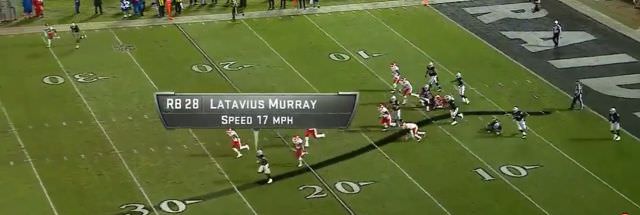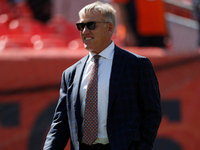Como a NFL – e não a NSA – está afetando a coleta de dados muito além da grade

Translating…
Zebras —
From the archives: Corporations watch the NFL using RFID tags to track player movements.
Video shot and edited by Christopher Schodt.
SANTA CLARA, Calif.—As guards were going so far as to check inside NFL fans’ wallets as part of routine security measures before a recent preseason game at Levi’s Stadium, a different form of surveillance was taking place on the inside of the San Francisco 49ers’ one-year-old, $1.3 billion home here in Silicon Valley.
We’re not talking about facial recognition devices, police body cams, or other security measures likely zeroing in on fans. Instead, employees from San Jose-based Zebra Technologies had recently finished scanning the NFL uniforms of the 49ers and of their opponents—the Dallas Cowboys. All of a sudden, an on-the-fieldde factosurveillance society was instantly created when Zebra techies activated nickel-sized Radio Frequency Identification Device (RFID) chips that were fastened inside players’ shoulder pads. Every movement of every player now could be monitored within an accuracy level of all but a few inches.
On its surface, this seems pretty innocuous. Cameras already track things like total player movement in sports, allowing teams to better recognize tendencies or gauge the physical toll on players. RFID chips, however, can provide more accurate, more granular information along these lines. The NFL’s new real-time player tracking data—including things such as player speed and team formations—undoubtedly promises to reformat the game in terms of fan participation, team practicing methods, and potentially game-time strategy.
There’s a larger story playing itself out as well. The league’s RFID initiative may push far beyond the gridiron.
That’s because this so-called geo-fencing technology has a geekier side, and it will likely recast things like fantasy football, the Microsoft’s Xbox One experience, and perhaps even the Madden NFL video game produced by Electronic Arts. What’s more, the technology potentially opens up new proposition gambling bets in Las Vegas sports books or other gambling venues. But its most unexpected impact will have nothing to do with sports at all. Fortune 500 companies are watching the NFL closely, examining how they might incorporate the RFID chip to monitor every move of their onsite employees from the construction site, the office, and beyond.
-
This is where the RFID device is hidden on both sides of an NFL player’s shoulder pads.
Christopher Schodt
-
From left to right, the evolution of Zebra Technologies’ RFID device attached to NFL players.
Christopher Schodt
-
Zebra Technologies techies manning in-stadium game day operations.
Christopher Schodt
-
In the bowels of Zebra Technologies’ off-stadium data center in San Jose, California.
Christopher Schodt
-
A close view of one of 20 onsite RFID receivers at Levi’s Stadium that triangulates player movements with the ability to do so from as far as 1,000 feet.
Christopher Schodt
-
A panoramic view of one of 20 onsite RFID receivers that triangulates player movements.
Christopher Schodt
-
Television viewers will be seeing this MPH stat more and more.
Zebra Technologies
-
Television viewers will also often see replay images showing the actual distance and path a player ran.
Zebra Technologies
-
This photo shows the passing routes traveled during a play.
-
A big-board computer monitoring screen at Zebra Technologies’ control center in San Jose, California.
Christopher Schodt
-
Some live action, pre-season football between the Dallas Cowboys at San Francisco 49ers on August 23, 2015.
Christopher Schodt
Game day
Starting this week, this is the first NFL season in which all NFL stadiums are outfitted with cigar-box-sized receivers across the venue to triangulate the players’ movements. These devices can track the players from up to 1,000 feet away, and at Levi’s Stadium, there are 20 of these receivers. Players and the field officials are tracked at least 15 times a second. The technology can even tell which way a player is facing in real time.
For now, the ball isn’t being tracked like it was in World Cup soccer matches last year. The NFL test-tracked the pigskin in last year’s Pro Bowl (the NFL equivalent of an all-star game), but American football isn’t like soccer. If the ball crosses the goal line in soccer, it’s a goal. In the NFL, action is dead and spotted wherever the ball is being carried when the ball carrier’s knee hits the ground when tackled. So while the NFL has instant replay to help officials, it isn’t about to automate or dehumanize the game’s officiating any further.
“We’re not looking to replace officials with robots,” Matt Swensson, the NFL’s senior director of emerging technology, told Ars.
According to Zebra, here’s the data being tracked in real time:
- Player participation.
- Player groupings.
- Play formation and route running.
- Player speed.
- Player separation from another player.
- Yards player ran in a game, yards run before and after catch, yards run by quarter. Virtually an unlimited variety of relevant distance data in real time.
And here are all thetechnical specifications(PDF) of Zebra’s player tracking system and servers.
“Basically, we can take all of the specifics that are tracked in a game and automate them,” Jill Stelfox, a Zebra general manager, told Ars. So in total, 2 to 3 gigs of data are generated per game under the current operation. However, the NFL for the moment is keeping most of the data under lock and key—and won’t even disperse it among the league’s own teams.
“Right now we’re still working through the proper distribution model of the data. We’re not just handing it over to the clubs to go through,” the NFL’s Swensson said.
Why keep everything centrally? It’s a combination of preparedness and competition. If the data is provided in real time to coaches during a game, that could influence the outcome, Swensson said. Coming up with the appropriate distribution channels and security measures for such a setup will require time and energy, and the NFL isn’t ready to go to that stage yet.
“Ultimately, we want the game to be fair and balanced,” Swensson said.
NFL teams can take advantage of this surveillance during practice. Only three teams currently do, according to Zebra’s Stelfox: the 49ers, Detroit Lions, and New Orleans Saints.
Sean Payton, the Saints’ head coach, said it only makes sense to surveil practices via RFID.
“For us it is distance, workload, travel, all of those things. Zebra has been great to work with. We think it is helpful for us to monitor workload,” Payton saidon the Saints’ website. He said he is able “to look for the exceptions when you are studying numbers. You are able to study and see maybe something that is unusual that stands out.” For example, Stelfox told us a story about Zebra’s technology discovering that running backReggie Bush, now of the 49ers, was running about 7 to 8 miles per practice.
“Why practice at that level? You can burn out,” Stelfox said.
Stelfox showed Ars some of the real-time data generated during last year’s Super Bowl on condition that it not be published. Looking through information collected, you could easily determine that when a certain player lined up in a certain spot, he was almost guaranteed to get the ball. So while top-level game film and old-school coaching could catch that, so does the Zebra technology—and it does so instantly.
“It’s super valuable data,” Stelfox said.
For now, fans watching on television will be some of the primary beneficiaries of the NFL’s great data experiment. Broadcasters can instantly get a limited amount of real-time data to provide viewers—like how far and how fast a player ran and the route taken.
But by making even this tiny of a fraction of datapublic, there are grand implications.
Listing image by Zebra Technologies




